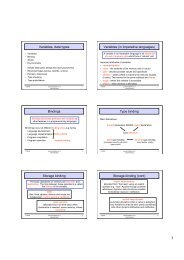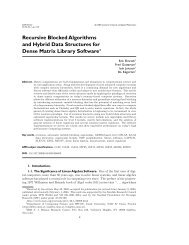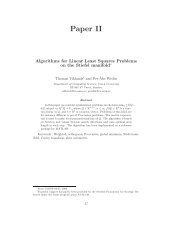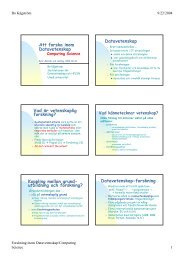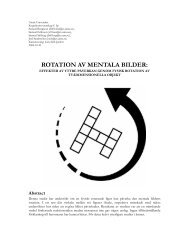Designing a persistent online strategy game - Department of ...
Designing a persistent online strategy game - Department of ...
Designing a persistent online strategy game - Department of ...
You also want an ePaper? Increase the reach of your titles
YUMPU automatically turns print PDFs into web optimized ePapers that Google loves.
34 Chapter 4. Models & methods for evaluating <strong>game</strong>s<br />
3. An ability to concentrate on the task at hand. In everyday life, all sorts <strong>of</strong> thoughts<br />
and worries constantly attract attention. During flow experience, all attention is<br />
concentrated at the task at hand, so there is no room for irrelevant information.<br />
4. A perceived sense <strong>of</strong> control over actions, and lack <strong>of</strong> a sense <strong>of</strong> worry about<br />
loosing control. Failing an activity in real life can have consequences that are hard<br />
to predict beforehand. It is also hard to predict the long term outcome <strong>of</strong> different<br />
actions. In <strong>game</strong>s, the consequences <strong>of</strong> failing are known or can be predicted in<br />
advance.<br />
5. The merging <strong>of</strong> action and awareness. All relevant skills are needed to cope with<br />
the challenge. There is no psychic energy left to process any other information.<br />
All attention is directed to the relevant stimuli. As a result people stop being<br />
aware <strong>of</strong> themselves as being separate from the actions they are performing.<br />
6. A loss <strong>of</strong> self-consciousness or preoccupation with self. This means to loose the<br />
image, or concept, <strong>of</strong> self, not a loss <strong>of</strong> self. Often people are highly aware <strong>of</strong> their<br />
bodies during the state <strong>of</strong> flow. An athlete is aware <strong>of</strong> all muscles in the body<br />
during exercise. The loos <strong>of</strong> self-consciousness can lead to a feeling <strong>of</strong> union with<br />
the environment and thus pushing the boundaries <strong>of</strong> being forward.<br />
7. The transformation <strong>of</strong> time. During flow the time does not pass like it normally<br />
does. Hours can fly by like minutes, but sometimes the opposite is true; an hard<br />
passage that in real time is over in seconds can feel like going on for minutes.<br />
One important aspect in the flow model that is also important in <strong>game</strong>s is the balance<br />
between skill and challenge [25]. When a player first start playing a <strong>game</strong>, her skills<br />
are basic and she does not know how to overcome all the challenges in the <strong>game</strong>. It is<br />
therefore important to have easy challenges in the beginning <strong>of</strong> the <strong>game</strong>. As the <strong>game</strong><br />
progress, the player skills become greater and greater and challenges that before were<br />
hard are now easy. Therefore the <strong>game</strong> has to <strong>of</strong>fer greater and harder challenges to<br />
keep the player the “flow zone” (see figure 4.3). This is the ideal <strong>of</strong> how a <strong>game</strong> should<br />
be designed. Unfortunately, players have different skills and expectations <strong>of</strong> the <strong>game</strong><br />
experience, some want to enjoy a moderately easy <strong>game</strong> and some want to devote all<br />
their skill in the <strong>game</strong> [6] (figure 4.4).<br />
One way to solve this problem is to <strong>of</strong>fer levels <strong>of</strong>f difficulty that the player can choose<br />
from in the beginning <strong>of</strong> the <strong>game</strong> (easy, medium and hard). The disadvantage with this<br />
approach is that the player is stuck with this choice for the rest <strong>of</strong> the <strong>game</strong>. Different<br />
players also develop their skills at different pace, so what is medium challenging for a<br />
player at the beginning <strong>of</strong> the <strong>game</strong> can be too easy or too hard at the end [6].<br />
Some <strong>game</strong>s let the player adjust the level <strong>of</strong> difficulty throughout the <strong>game</strong> by <strong>of</strong>fering<br />
several choices to the player. The player can for example be given several alternatives<br />
with variable difficulty to complete a mission. The problem with this approach is that<br />
it can be costly to implement. Too many alternatives could also confuse the player, and<br />
so disturb the sense <strong>of</strong> flow [6].<br />
According to Chen [6] the best way to provide an enjoyable experience for all types <strong>of</strong><br />
users is to embed all choices in the core activities. That means that when the player<br />
becomes more experienced she can perform more actions and therefore choose how to<br />
play herself. This is how it <strong>of</strong>ten works in the real world, whether it is skating, sewing



